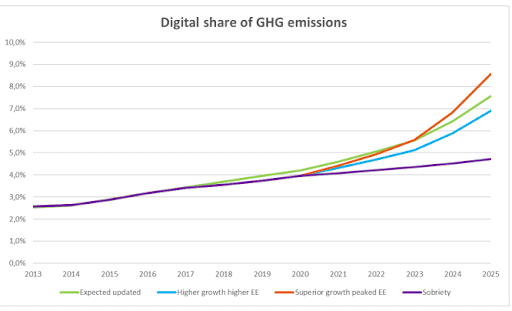Environmental sustainability, simply put, is the process of interacting with the environment in a responsible way so as to avoid degradation or depletion of natural resources, allowing for long-term environmental quality. Environmental sustainability both affects and is affected by technology.
Programmers and the technology they create and use are threatening environmental sustainability and negatively affecting global climates—as part of the process of the anthropogenic (human-caused) climate crisis.
However, hardly any programmers consider the impact they have on the environment.
According to a recent report, the internet contributed about 3.8% of planet-wide greenhouse gas emissions in 2018, and it’s predicted that global carbon emissions from the information and communication technology (ICT) industry will reach 14% by the year 2040.
The graph below from a recent study shows the distribution of energy consumption:

Most people have a hard time imagining this being true, as they don’t consider the internet as an actual physical product. However, internet applications can be silent killers when it comes to things like carbon emissions because the industry is primarily fossil-fuel-driven.
For example, if a company’s developers writing lines of code are burning needless computing power, then it means that they’re not only burning cash, but they are also wasting a lot of fossil fuels through their lack of energy efficiency. The irony here is that many internet companies brand themselves as being environmentally friendly.
When you think about it this way, it becomes easy to see why it’s important to make efficiencies in both hardware and software as part of programmers’ efforts to help slow down climate change.
The good news is that it is possible to build environmental sustainability into your development processes.
With that good news, let’s dive into how environmental sustainability affects and is affected by technology, and the different ways to tackle this growing problem.
Impact of Tech on Climate Change—Are Programmers Responsible?
Technology as a whole is making massive contributions to the carbon footprint. But what role do programmers play in it?
Before we can determine the answer to that, let’s first take a look at exactly how tech impacts climate change.
How Does Tech Impact Climate Change?
Compared to other industries, such as manufacturing, food, fashion, etc., eco-friendliness in the ICT industry leaves a lot to be desired. In fact, some studies have shown that ICT may be more problematic than other commonly thought-of industries.
Although there are a lot of ways that IT affects resources, most people are only vaguely aware of them.
For example, devices in the office such as servers, desktops, laptops, phones, etc. need constant energy sources. Moreover, in addition to the high levels of energy consumption, these devices also release significant GHG emissions, particularly at the beginning of the device’s life, when it’s being built.
In other words, devices that you consider to be just sitting dormant between uses are in fact significantly contributing to climate change concerns.
Furthermore, some devices (servers, in particular) generate heat that requires additional energy in order to cool down the computing equipment. The following are ways in which unnecessary energy is consumed—together with some ideas on how to address them:
- Use of Non-Renewable Energy Sources: Although a lot of tech organizations like Microsoft, Google, Infosys, and others have begun to use green energy sources in an effort to combat carbon emissions, many businesses, residences, and large data warehouses are still using non-renewable energy sources.
- Non-Eco-Friendly Upgrades: Many programmers fail to track the consumption of resources to ensure that software used is eco-friendly. For example, they deploy software upgrades for devices, which leads to increased battery consumption, showing that the upgrade itself may not be eco-friendly.
- Use of Unsustainable Practices: A lot of practices contribute to the carbon footprint. By conducting an internal audit, organizations can evaluate all current processes that developers follow across the value chain in order to highlight unsustainable practices and take the necessary actions such as assessing the source of power, turning off unused appliances, optimizing data centers, etc.
- Lack of Operational Efficiency: It’s important to look for ways of reducing storage and power use in data centers. For instance, you can use data center management software to improve operational efficiency and analyze bottlenecks and use data center temperature monitoring tools—such as smart temperature controls—to reduce energy usage by turning off the data center cooling devices when the right temperature is reached.
These are just a few of the many ways tech impacts climate change and how programmers and their organizations can adopt better and more sustainable approaches.
It’s clear that sustainability and IT are often at odds. For example, server farms that are the backbone of all internet searches and emails sent take up a ton of resources. Additionally, when laptops, phones, and other devices get made or are recycled, a lot of energy is spent, which means tons of greenhouse gasses (GHG) are released into the environment.
This means that even when you think that you’re helping to reduce your environmental impact, you’re likely still contributing to environmental problems.
Before we get into how companies and programmers can create more sustainable decisions when it comes to IT, let’s see how programmers are specifically contributing to the lack of environmental sustainability in tech.
What Role Do Programmers Play?

- The use of automated technologies for excavation, processing, refinement, and distribution of fossil fuels coded by programmers are responsible in part for negatively affecting the climate and environment. Even though integrating an automation platform can be beneficial in all cases, companies should try to use it for high-priority business tasks.
- Additionally, other technologies used to extract, transfer, store, and analyze data by oil companies and other companies that profit from environmental exploitation are coded by programmers. For those that are trying to help create a more sustainable future, this shouldn’t be an industry you’re willing to work in.
- Failure to extend sustainability to users. For example, programmers can reduce the energy consumption of software products, leading to simpler processes and improved performance. This increases efficiency by reducing glitches and enhancing processing time. Programmers can also deploy software upgrades designed to increase memory consumption while maintaining speed in devices, thereby increasing their life span.
While programmers play a small role in the process directly, indirectly they can make a significant impact based on the decisions that they make. As many businesses are doing today, programmers can constantly innovate toward a better tomorrow while adopting sustainability.
So let’s take a look at a few climate-focused tech solutions that programmers can implement starting right now.
Climate-Focused Tech Solutions—What Can Programmers Do?
There’s no denying that the impact of technology on the environment is becoming a very serious issue. Luckily, there are a lot of things you, as a programmer, can do to help reduce these threats and potentially protect global ecosystems from rising temperatures, rapidly shifting climate patterns, and superstorms caused or exacerbated by the climate crisis.
You’ll find plenty of resources online, such as the Principles of Sustainable Software Engineering that set out best practices for defining, building, and running sustainable software applications. These include things that make it clear that everyone in the tech industry has a part to play:
- Carbon: Build carbon-efficient applications.
- Electricity: Building faster websites that require fewer requests can help reduce the amount of energy required by web servers.
- Carbon Intensity: Build apps that consume electricity with the lowest carbon intensity.
- Embodied Carbon: Build hardware-efficient applications.
- Energy Proportionality: Maximize hardware energy efficiency.
- Networking: Reduce the distance data needs to travel across the network.
- Demand Shaping: Build carbon-aware applications.
- Measurement and Optimization: Focus on optimizing overall carbon efficiency across the entire organization.
To help address these concerns, here are a few possible solutions that are relevant to programmers and anyone else involved in building, deploying, and managing applications:
- Use solar, wind, or geothermal energy at data warehouses. These alternative energy sources help to follow data center best practices such as harnessing outside air cooling, automating controls for lights, security, etc. and separating aisles based on cold and hot temperatures.
- Take action and use your programming skills to help scientists model the impacts of the climate crisis.
- Be active in the goal to develop technologies that aim to reduce the impact of the climate crisis and superstorms.
- Refuse to code or program for companies that are leading the world toward ecological catastrophes, such as oil companies and others that profit directly from the worst forms of environmental exploitation.
- Develop green alternatives to Bitcoin and proof of work (PoW) Cryptocurrencies.
- Use practices like green coding to produce algorithms that reduce energy consumption during the use of the software as a way to extend sustainability to users.
- Sift through customer reviews and analyze relevant ones to find any hidden sustainability problems. For example, customers might talk about higher battery consumption after a device software upgrade, which would be a possible signal showing that the upgrade isn’t eco-friendly.
- Relocate or co-locate servers to maximize space at your data center as much as possible. This will minimize your energy and cooling costs significantly. If possible, you might even consider relocating your service to climates that are colder, as this will result in a reduction in carbon emissions.
- Migrate to the cloud, as cloud energy is considered more efficient because of the economy of scale.
- Use state-of-the-art IT systems, since legacy systems often require more power. Additionally, their large size often means more heat output that requires additional cooling. As a programmer looking to promote sustainability, you can determine the most applicable solutions to your needs so you can experience higher energy savings.
Extending the Conversation

For example, you can educate your clients on the different ways they are responsible for sustainability. Here are a few ways you can discuss with others how to promote green IT:
- Setting Computers to Sleep: Shutting down laptops or putting computers to sleep is one way in which users can reduce energy consumption. You can set monitors to switch off after 15 minutes of inactivity and hard disks even sooner than that: five minutes with no activity.
- Upgrading to Smart Power Strips: Smart strips help to cut down on the type of vampire energy consumed by TVs, computers, and other peripheral devices.
- Share Printers: If you don’t need the use of a printer often, you might consider whom to share with, whether at home or in the office.
- Working Remotely: If your daily commute doesn’t involve walking or biking, then you might consider working from home as a way to help reduce GHG emissions that are associated with commuting.
There are many methods of education, but the most important thing to remember is to try to make things fun and entertaining.
After all, the climate crisis and environmental sustainability can be heavy topics, so you could ask someone experienced with graphic design software to create memes, images, infographics, or other visual content to help your clients better digest the material.
By raising awareness and educating others about the impact of their individual actions, you’re likely to change their mindset and habits so that more of your customers become environmentally conscious. Nowadays, a lot of specialists can work from home and reduce the number of cars on the road. Eliminating the daily commute of millions of workers seems like a simple climate victory.
A Summary for the Future of Humanity—A Final Look at Environmental Sustainability in Tech
Technology is a powerful force for driving progress, but as programmers, we can’t ignore the detrimental impact it has on sustainability.
Whether you are coding websites from scratch or using a professional website builder to facilitate your efforts, every act of programming, coding, and designing requires energy.
The tech industry continues to consume and release energy in a growing and never-ending cycle, which is why it’s all the more important for those in the industry to adopt sustainable practices in order to contribute to a greener future.
Many large organizations have already begun the journey toward net-zero environments as a way to help the environment. Nonetheless, eco-friendliness in the technology industry is still falling way short, and programmers must do their part to avert climate disaster by following the best practices outlined in this article.
Additionally, to fight the climate crisis, programmers may have to make sacrifices such as accepting lower salaries or volunteering their time in ways they wouldn’t usually do.
It’s up to you to consider taking proactive steps now to help reduce the threat of a future ecological apocalypse caused by the current climate crisis—for the future of humanity.
Over to you. What are you doing right now to build environmental sustainability into your development processes as a way to help stave off climate change? Let us know in the comments below!
